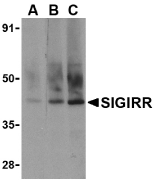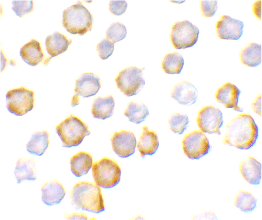SIGIRR antibody


Rabbit anti SIGIRR (C-Terminal)
- Product Type
- Polyclonal Antibody
- Isotype
- Polyclonal IgG
- Specificity
- SIGIRR
- Region
- (C-TERMINAL)
| Rabbit anti SIGIRR (C-terminal) antibody recognizes the Single Ig IL-1-related receptor, also known as SIGIRR, Single immunoglobulin domain-containing IL1R-related protein, Toll/interleukin-1 receptor 8 or TIR8. SIGIRR is a 409 amino acid ~ 45-90 kDa single pass type III transmembrane glycoprotein, Multiple species of SIGIRR seen in western blotting are achieved through differential glycosylation at four potential glycosylation sites in the SIGIRR ectodomain, mutation at these sites to eliminate glycosylation yields a single band of the predicted size (44 kDa) for unmodified SIGIRR (Zhao et al. 2015). SIGIRR is a member of the Toll-like receptor-interleukin 1 receptor superfamily, defined by an intracellular Toll-IL-1R (TIR) domain. SIGIRR acts as a negative regulator of the Toll-like and IL-1R receptor signalling pathways. It interacts with TLR4, TLR5, TLR9 and IL-1R through the extracellular Ig domain, or the intracellular TIR domain. The Ig domain interferes with the heterodimerization of IL-1R while the intracellular TIR domain inhibits both IL-1 and LPS signalling by attenuating the recruitment of receptor-proximal signalling components to TLR4. SIGIRR is expressed in kidney, colon, small intestine, lung, spleen and liver. It is not expressed in brain or muscle. Rabbit anti SIGIRR antibody has been successfully used for the detection of SIGIRR in both murine and human samples by western blotting (Zhao et al. 2015) |
- Target Species
- Mouse
- Species Cross-Reactivity
-
Target Species Cross Reactivity Human Rat Expected from Sequence - N.B. Antibody reactivity and working conditions may vary between species.
- Product Form
- Purified IgG - liquid
- Antiserum Preparation
- Antiserum to SIGIRR (CT) was raised by repeated immunisation of with highly purified antigen. Purified IgG was prepared from whole serum by immunoaffinity chromatography.
- Buffer Solution
- Phosphate buffered saline
- Preservative Stabilisers
- 0.02% Sodium Azide (NaN3)
- Immunogen
- A synthetic peptide corresponding to 15 amino acids near the carboxy terminus of mouse SIGIRR.
- Approx. Protein Concentrations
- IgG concentration 1.0mg/ml
- Regulatory
- For research purposes only
- Guarantee
- 12 months from date of despatch
Avoid repeated freezing and thawing as this may denature the antibody. Storage in frost-free freezers is not recommended.
| Application Name | Verified | Min Dilution | Max Dilution |
|---|---|---|---|
| Immunohistology - Frozen | 10ug/ml | ||
| Western Blotting | 0.5 | 1ug/ml |
- Western Blotting
- AHP1784 detects a band of approximately 43kDa in A549 cell lysate
| Description | Product Code | Applications | Pack Size | List Price | Your Price | Quantity | |
|---|---|---|---|---|---|---|---|
| Goat anti Rabbit IgG (Fc):Biotin | STAR121B | E WB | 1 mg |
|
Log in | ||
| List Price | Your Price | ||||||
|
|
Log in | ||||||
| Description | Goat anti Rabbit IgG (Fc):Biotin | ||||||
| Goat anti Rabbit IgG (Fc):FITC | STAR121F | F | 1 mg |
|
Log in | ||
| List Price | Your Price | ||||||
|
|
Log in | ||||||
| Description | Goat anti Rabbit IgG (Fc):FITC | ||||||
| Goat anti Rabbit IgG (Fc):HRP | STAR121P | E WB | 1 mg |
|
Log in | ||
| List Price | Your Price | ||||||
|
|
Log in | ||||||
| Description | Goat anti Rabbit IgG (Fc):HRP | ||||||
| Goat anti Rabbit IgG (H/L):HRP | STAR124P | C E WB | 1 mg |
|
Log in | ||
| List Price | Your Price | ||||||
|
|
Log in | ||||||
| Description | Goat anti Rabbit IgG (H/L):HRP | ||||||
| Sheep anti Rabbit IgG:RPE | STAR35A | F | 1 ml |
|
Log in | ||
| List Price | Your Price | ||||||
|
|
Log in | ||||||
| Description | Sheep anti Rabbit IgG:RPE | ||||||
| Description | Product Code | Applications | Pack Size | List Price | Your Price | Quantity | |
|---|---|---|---|---|---|---|---|
| TidyBlot Western Blot Detection Reagent:HRP | STAR209P | WB * | 0.5 ml | Log in | |||
| List Price | Your Price | ||||||
| Log in | |||||||
| Description | TidyBlot Western Blot Detection Reagent:HRP | ||||||
References for SIGIRR antibody
-
Zhao, J. et al. (2015) Human Colon Tumors Express a Dominant-Negative Form of SIGIRR That Promotes Inflammation and Colitis-Associated Colon Cancer in Mice.
Gastroenterology. 149 (7): 1860-1871.e8.
- Synonyms
- TIR8
- RRID
- AB_2188895
- UniProt
- Q9JLZ8
- Q6IA17
- Entrez Gene
- SIGIRR
- Sigirr
- GO Terms
- GO:0005515 protein binding
- GO:0001960 negative regulation of cytokine-mediated signaling pathway
- GO:0006953 acute-phase response
- GO:0016021 integral to membrane
- GO:0004888 transmembrane receptor activity
- GO:0031665 negative regulation of lipopolysaccharide-mediated signaling pathway
- GO:0043433 negative regulation of transcription factor activity
- GO:0045079 negative regulation of chemokine biosynthetic process
- GO:0045087 innate immune response
- View More GO Terms
AHP1784
If you cannot find the batch/lot you are looking for please contact our technical support team for assistance.
Please Note: All Products are "FOR RESEARCH PURPOSES ONLY"
View all Anti-Mouse ProductsAlways be the first to know.
When we launch new products and resources to help you achieve more in the lab.
Yes, sign me up
